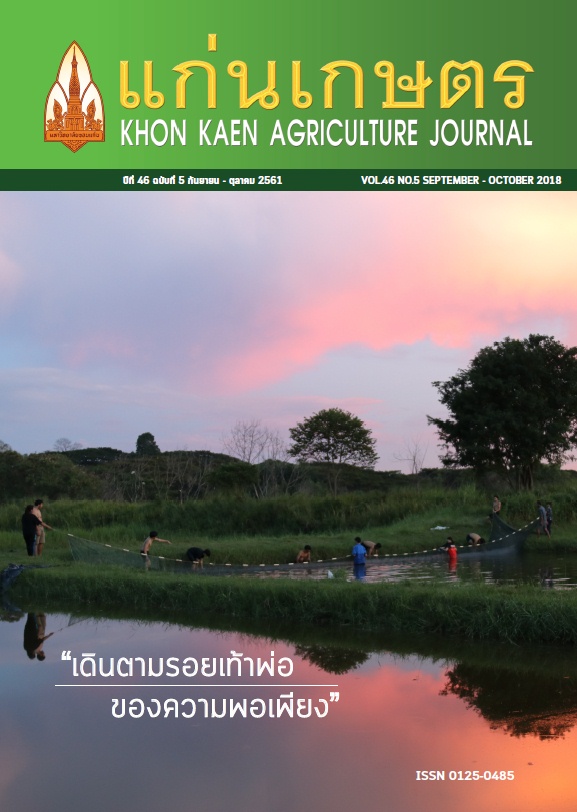ผลการเพาะเลี้ยงปลานิลแดงวัยอ่อนในระบบไบโอฟลอค
Main Article Content
บทคัดย่อ
การเพาะเลี้ยงสัตว์น้ำด้วยระบบไบโอฟลอคมีความเป็นมิตรกับสิ่งแวดล้อม เนื่องจากมีการใช้น้ำอย่างจำกัด และน้ำทิ้งที่ปล่อยออกมาสู่สิ่งแวดล้อมน้อย ในการศึกษาได้ทำการประเมินอัตราการรอด การเจริญเติบโต และการจัดการคุณภาพน้ำในปลานิลแดงวัยอ่อน (Oreochromis niloticus-mossambicus) ซึ่งในการทดลองใช้ลูกปลานิลแดงน้ำหนักเฉลี่ย 4.86±0.01 กรัม ทดลองในตู้ปลา ปริมาตรน้ำ 50 ลิตร อัตราการปล่อย 10 ตัว/ตู้ แบ่งการทดลองออกเป็น 3 ชุด ๆ ละ 3 ซ้ำ ได้แก่ ชุดที่ 1 คือชุดควบคุม โดยเลี้ยงในระบบปกติที่มีการเปลี่ยนถ่ายน้ำ ชุดที่ 2 คือชุดที่เลี้ยงโดยระบบไบโอฟลอคจากน้ำเขียวจากฟาร์มปลาดุก และชุดที่ 3 คือชุดที่เลี้ยงโดยระบบไบโอฟลอคจากน้ำประปา ทำการให้อาหารที่มีเปอร์เซ็นต์โปรตีนประมาณ 35-40% อัตราการให้ 10% ต่อน้ำหนักตัว ทำการเลี้ยงเป็นระยะเวลา 10 สัปดาห์ เติมกากน้ำตาล (แหล่งคาร์บอน) ในชุดไบโอฟลอค ปรับสัดส่วน C:N ≥ 15 ตรวจสอบคุณภาพน้ำได้แก่ pH, DO, NH3-N และ NO2 ̄-N เมื่อสิ้นสุดการทดลองพบว่าคุณภาพน้ำอยู่ในเกณฑ์มาตรฐาน ระบบไบโอฟลอคสามารถควบคุมปริมาณแพลงก์ตอนพืช (คลอโรฟิลล์ เอ) ไม่ให้สูงเกินไป รวมทั้งปลาที่เลี้ยงด้วยระบบไบโอฟลอคมีอัตราการรอดสูงกว่าชุดควบคุมอย่างมีนัยสำคัญ (P<0.05) ปลานิลแดงที่เลี้ยงโดยไบโอฟลอคด้วยน้ำจากฟาร์มปลาดุกมีน้ำหนักเฉลี่ย ค่าน้ำหนักที่เพิ่มต่อวัน (ADG) และอัตราการเจริญเติบโตจำเพาะ (SGR) สูงที่สุด คือ 54.80±0.19 กรัม, 10.25±0.02 กรัม/วันและ 2.15±0.01% ต่อวัน ตามลำดับ (P<0.05) ในขณะที่อัตราการเปลี่ยนอาหารเป็นเนื้อ (FCR) มีค่าต่ำกว่าชุดควบคุมอย่างมีนัยสำคัญ (P<0.05) เนื้อปลาที่เลี้ยงในระบบไบโอฟลอคมีปริมาณโปรตีนมากกว่าชุดควบคุมอย่างมีนัยสำคัญ (P<0.05)
Article Details
เอกสารอ้างอิง
วีระ ตั้งชวาล. 2545. เคมีของน้ำและการบำบัดน้ำเสีย. คณะวิทยาศาสตร์ มหาวิทยาลัยศรีนครินทรวิโรฒ, กรุงเทพฯ.
อุดมลักษณ์ สมพงษ์. 2558. คู่มือปฏิบัติการวิชา พล 312 คุณภาพน้ำสำหรับการเพาะเลี้ยงสัตว์นน้ำ. คณะเทคโนโลยีการประมงและทรัพยากรทางน้ำ มหาวิทยาลัยแม่โจ้ เชียงใหม่.
APHA, AWWA and WEF. 1998. Standard Methods for the Examination of water and Wastewater. United Book Press, Inc. Washington DC, USA.
AOAC. 1990. Official Methods of Analysis of the AOAC, 15th ed. Association of official analytical chemists. Arlington, VA, USA.
Avnimelech, Y. 2015. Biofloc Technology-A Practical Guidebook, 3rd ed. The World Aquaculture Society, Baton Rouge, Louisiana, USA.
Azim, M.E. and D.C. Little. 2008. The biofloc technology (BFT) in indoor tanks: Water quality, biofloc composition, and growth and welfare of Nile tilapia (Oreochromis niloticus). Aquaculture. 283: 29–35.
Boyd, C.E. and C.S., Tucker. 1998. Pond Aquaculture Water Quality Management. Springer Science Business Media, New York, USA.
Boyd, C.E. and C.S. Tucker. 2014. Handbook for Aquaculture Water Quality. Craftmaster Printers, Inc. Auburn, Alabama, USA
Correia, E.S., J.S. Wilkenfeld, T.C. Morris, L. Wei, D.I. Prangnell, and T.M. Samoch. 2014. Intensive nursery production of the Pacific white shrimp Litopenaeus vannamei using two commercial feeds with high and low protein content in a biofloc-dominated system. Aquacultural Engineering. 59: 48–54.
Crab, R., T. Defoirdt, P. Bossier, and W. Verstraete. 2012. Biofloc technology in aquaculture: beneficial effect and future challenges. Aquaculture. 356-357: 351-356.
El-Sayed, A.E.M. 2006. Tilapia Culture. CAB International, Oxfordshire, UK.
Gaona C. A. P., F. da P. Serra, P. S. Furtado, L. H. Poersch, and W. Jr. Wasielesky. 2016. Effect of different total suspended solids concentrations on the growth performance of Litopenaeus vannamei in a BFT system. Aquacultural Engineering. 72–73: 65–69.
ISO 10260. 1992. Water quality-measurement of biochemical parameters-spectrometric determination of the chlorophyll-a concentration. International Organization for Standardization, Geneva, Switzerland.
Martinez-Cordova L.R., M. Emerenciano, A. Miranda-Baeza, and M. Martinez-Porchas. 2014. Microbial-based systems for aquaculture of fish and shrimp: an updated review. Reviews in Aquaculture. 6: 1–18.
Rodrigo, S., A. Rafael, F.B. Manecas, F.S.C. Patricia, V.A. Luis, Q.S. Walter, and R. A Edemar. 2013. Use of artificial substrates in the culture of Litopenaeus vannamei (biofloc system) at different stocking densities: Effects on microbial activity, water quality and production rates. Aquacultural Engineering. 1676: 1-11.
Zhao, Z., Q. Xu, L. Luo, C. Wang, J. Li, and L. Wang. 2014. Effect of feed C/N ratio promoted bioflocs on water quality and production performance of bottom and filter feeder carp in minimum-water exchanged pond polyculture system. Aquaculture. 434: 442–448.


